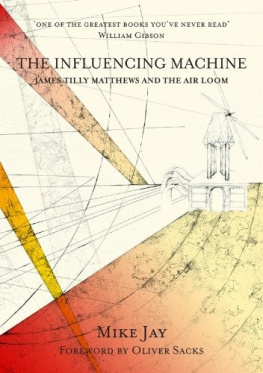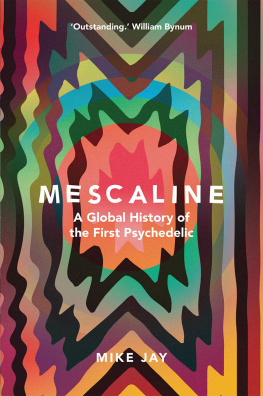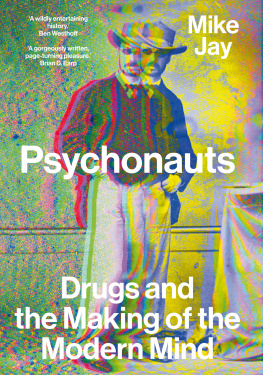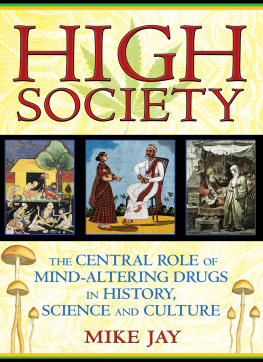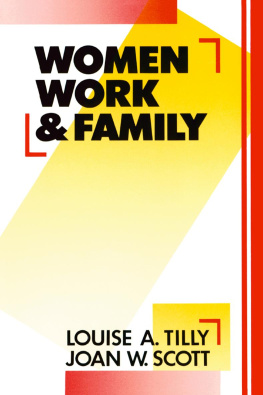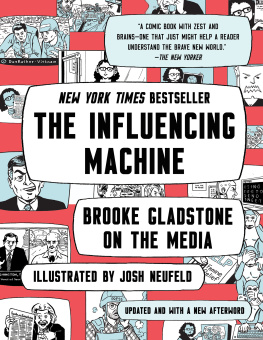Mike Jay - The Influencing Machine: James Tilly Matthews and the Air Loom
Here you can read online Mike Jay - The Influencing Machine: James Tilly Matthews and the Air Loom full text of the book (entire story) in english for free. Download pdf and epub, get meaning, cover and reviews about this ebook. year: 2012, publisher: Strange Attractor, genre: Detective and thriller. Description of the work, (preface) as well as reviews are available. Best literature library LitArk.com created for fans of good reading and offers a wide selection of genres:
Romance novel
Science fiction
Adventure
Detective
Science
History
Home and family
Prose
Art
Politics
Computer
Non-fiction
Religion
Business
Children
Humor
Choose a favorite category and find really read worthwhile books. Enjoy immersion in the world of imagination, feel the emotions of the characters or learn something new for yourself, make an fascinating discovery.
- Book:The Influencing Machine: James Tilly Matthews and the Air Loom
- Author:
- Publisher:Strange Attractor
- Genre:
- Year:2012
- Rating:5 / 5
- Favourites:Add to favourites
- Your mark:
- 100
- 1
- 2
- 3
- 4
- 5
The Influencing Machine: James Tilly Matthews and the Air Loom: summary, description and annotation
We offer to read an annotation, description, summary or preface (depends on what the author of the book "The Influencing Machine: James Tilly Matthews and the Air Loom" wrote himself). If you haven't found the necessary information about the book — write in the comments, we will try to find it.
Mike Jay: author's other books
Who wrote The Influencing Machine: James Tilly Matthews and the Air Loom? Find out the surname, the name of the author of the book and a list of all author's works by series.
The Influencing Machine: James Tilly Matthews and the Air Loom — read online for free the complete book (whole text) full work
Below is the text of the book, divided by pages. System saving the place of the last page read, allows you to conveniently read the book "The Influencing Machine: James Tilly Matthews and the Air Loom" online for free, without having to search again every time where you left off. Put a bookmark, and you can go to the page where you finished reading at any time.
Font size:
Interval:
Bookmark:
A tale of the madness of politics
and the politics of madness
T HE I NFLUENCING M ACHINE
J AMES T ILLY M ATTHEWS A ND T HE A IR L OOM
M IKE J AY
Previou s ly published by Transworld Publis h ers as
The Air Loom Gang (2003)
This digital Kindle edition, Strange Attractor Press 2012
Mike Jay 2012
Cover by Jennifer Crouch
ISBN: 978-1-907222-22-1
Images from the original book have been reproduced to the best abilities of the Kindle device.
Mike Jay has asserted his moral right to be identified as the author of this work in accordance with the Copyright, Designs and Patents Act, 1988.
All rights reserved. No part of this publication may be reproduced in any form or by any means without the written permission of the publishers.
A CIP catalogue record for this book is available from the British Libr a ry.
Strange Attractor Press
BM SAP, London, WC1N 3XX, UK
www.strangeattractor.co.uk
FOREWORD
Why do people go mad? Is it just chemical, something physical, something amiss in the brain? Or is there always an accumulation of personal and historical factors which push the schizophrenic person overboard? Mike Jay here examines these questions in light of the famous case of James Tilly Matthews, a brilliant architect who, early in the nineteenth century, was confined in Bedlam for nearly twenty years and written up in detail by his psychiatrist as an incurable lunatic. Matthewss delusions centered around an imagined Air Loom a machine able to influence and control his own and others thoughts and in this we encounter for the first time the modern form of schizophrenic paranoia one able to draw on all the new technology and theories of the late eighteenth century: its airpumps, its pneumatic chemistry, its notions of magnetic or mesmeric rays (prior to this such delusions had a theological flavor, and were centered on witches, demons, or God).
I have never seen the logic of madness, of a particular delusion, presented so clearly and convincingly. The Influencing Machine is a wonderful book to read, combining exceptional scholarship and psychological insight with deep empathy for the tormented but always gentle and dignified Matthews. And it is beautifully written, with all the drama, the rich characterization, the subtlety, of a fine novel.
Oliver Sacks M.D.
1. THE AIR LOOM
In some apartment near London Wall, there is a gang of villains profoundly skilled in Pneumatic Chemistry...
John Haslam, Illustrations of Madness , 1810
On 30 December 1796 one man was on an unbelievable mission, and in unbelievable jeopardy.
His mission was taking him through the packed thoroughfares of London, the worlds largest city teeming with a million inhabitants, to the House of Commons: the most public place in Britain where truth, once spoken, could not be ignored. His jeopardy, by contrast, emanated from the most private place in London: an underground cellar concealed somewhere beneath the paving and cobbles of the city centre whose existence was, as far as he knew, a secret to everyone but him.
The House of Commons was not Pugin and Barrys Victorian gothic icon of today but, in the words of a disappointed German visitor in 1782, rather a mean-looking building, that not a little resembles a chapel. Indeed it was a chapel: a plain stone single-celled building with a steeply sloping roof, a Tudor adjunct to the Palace of Westminster that had been co-opted as the House of Commons chamber over two centuries before and still served its new secular ministers. It stood in a courtyard, surrounded by the Palaces other structures the Law Courts, the House of Lords and backing onto the Thames, where Westminster Steps teemed with river traffic, a melee of barges and their passengers, goods and their traders.
He approached the House seemingly unnoticed, yet he was well aware that it would nonetheless require a powerful effort of will for him to reach it. There was no-one pursuing him, and no-one to block his way. But neither of these were necessary. The jeopardy he faced was generated by something new to science and to history: a machine that operated invisibly, from a distance and with irresistible force.
He was aware that, in the darkness of its basement cellar, the machine was in operation. Although the cellar was dank and airless, the windmill sails that powered it were turning hypnotically, filling it with its mysterious charge. Its rows of hooped brass barrels hissed conspiratorially as their chambers filled with pressurised gases. Its wooden levers creaked as the warp of its central loom was tensed by magnetic currents. The man tasted copper in his saliva.
He passed through the doors to the House of Commons. Inside, its origins as a chapel were unmistakable: a single vaulted space, with ante-chapel and chapel separated by a screen into lobby and debating chamber. The Speaker, in a huge wig with two knotted tresses, sat on a raised dais behind the former altar with the gilt sceptre lying upon it, backlit by three arched chapel windows. The members benches, covered with green cloth, were the old chapel stalls, stacked in a steep rake into an area little larger than a tennis court. Above them, the only modern improvement: Christopher Wrens gallery, more raked seats set into the walls fifteen feet up, where visitors could take their chances on finding a space between the members who overflowed onto the higher perches.
In the cellar, the machine was cranking towards full power. Its gases and fluids agitated intensely, with a muffled cacophony of swishing and crashing sounds like ocean turbulence in a subterranean cavern. The smell was foul beyond belief, noxious gases and corrosive acids ripped apart and recombined in the magnetic flux. Factitious airs gases that had never existed in nature hissed ominously into being, jets of pressure forcing them through tubes and valves, sending them out like sightless eels into their new world. A pair of gloved hands worked in silence, modulating the keys on the machine like organ stops, focusing an invisible force out beyond the cellars mouldering stone walls, through the London streets, where it passed without resistance through walls, houses and crowds, infallibly seeking out its target.
As he climbed the steep, crowded stairs to the public gallery, he began to feel a turbulence in the air around him, and a probing pressure around his mouth, sucking at his breath. He knew what this meant: the bellows on the machines controls were being delicately primed, feeling for the rhythm of his breathing and attempting to synchronise with it. Each time he filled his lungs he felt a little more of the magnetic fluid seeping into them, into his bloodstream and brain. Each breath dulled his mind a little, like a shadow passing over the sun.
He knew what to do. He opened his mouth and held his breath for as long as he could, then took in a sharp, unexpected draught of air. The lever of the bellows, at its lowest arc, was raised immediately, but the magnetic fluid seeped out too slowly to reach him. The machine, he had discovered, could be temporarily fooled in this way. He expelled the breath from his lungs sharply, sucked it in again immediately and held his mouth wide open, like a suffocating fish. He could hear a faint, frustrated hissing around him as it searched again for his rhythm. The clerks and politicians on the stairs looked at him oddly, and he clutched his chest in a pantomime of asthmatic attack.
He reached the public gallery, and jostled his way into earshot and towards a seat. Both house and gallery were packed. A random visit would likely have found members stretched out on benches, cracking nuts, eating oranges, sleeping or gossiping. But today there were nearly three hundred MPs in attendance for a debate crucial to the nations political future: on the possibility of peace with France.
Font size:
Interval:
Bookmark:
Similar books «The Influencing Machine: James Tilly Matthews and the Air Loom»
Look at similar books to The Influencing Machine: James Tilly Matthews and the Air Loom. We have selected literature similar in name and meaning in the hope of providing readers with more options to find new, interesting, not yet read works.
Discussion, reviews of the book The Influencing Machine: James Tilly Matthews and the Air Loom and just readers' own opinions. Leave your comments, write what you think about the work, its meaning or the main characters. Specify what exactly you liked and what you didn't like, and why you think so.

